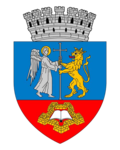
Back Oradea ACE Oradea Afrikaans Oradea GSW أوراديا Arabic اوراديا ARZ Oradea AST اورادئا AZB Арадзя Byelorussian Арадзя BE-TARASK Орадя Bulgarian
This article has multiple issues. Please help improve it or discuss these issues on the talk page. (Learn how and when to remove these messages)
|
Oradea
Nagyvárad (Hungarian) | |
|---|---|
Overview of the Ferdinand Square | |
 Location within Bihor County | |
Location within Romania | |
| Coordinates: 47°04′20″N 21°55′16″E / 47.07222°N 21.92111°E | |
| Country | |
| County | Bihor County |
| Government | |
| • Mayor (2020–2024) | Florin Birta[1] (PNL) |
| Area | |
| 115.56 km2 (44.62 sq mi) | |
| Elevation | 142 m (466 ft) |
| Population | |
| 183,105 | |
| • Rank | 9th |
| • Density | 1,600/km2 (4,100/sq mi) |
| • Metro | 245,537 |
| Time zone | UTC+2 (EET) |
| • Summer (DST) | UTC+3 (EEST) |
| Postal code | 4101xx |
| Area code | (+40) 59 |
| Vehicle registration | BH |
| Official language | Romanian |
| Recognized minority language | Hungarian[3] |
| Patron saint | Saint Ladislaus[4] |
| Climate | Dfb |
| Website | oradea |
Oradea (UK: /ɒˈrɑːdiə/, US: /ɔːˈr-, -djɑː/,[5][6][7] Romanian: [oˈrade̯a]; Hungarian: Nagyvárad [ˈnɒɟvaːrɒd]; German: Großwardein [ˌɡʁoːsvaʁˈdaɪn]) is a city located in the Crișana region of Romania. It serves as the administrative seat of Bihor County and is an economic, social, and cultural hub in northwestern Romania. The city lies between rolling hills on the Crișana plain on both banks of the Crișul Repede river.
The city is Romania's ninth most populous (as of 2021) and lies approximately 10 km (6.2 mi) from the Hungarian border.[2][8] It covers 11,556 hectares (28,560 acres) between the Apuseni Mountains and the Crișana-Banat plain.
According to a study conducted by a real estate firm, Oradea has the second-highest standard of living and is the second-most advantageous city in Romania.[9] It serves as the region’s major industrial and economic hub hosting several of the country's largest industrial enterprises. The city possesses Art Nouveau architecture and is a member of both the Réseau Art Nouveau Network and the Art Nouveau European Route.
- ^ "Primăria Oradea ["Oradea Townhall", official website.] Primar ["Mayor"]" (in Romanian). Retrieved 5 January 2021.
- ^ a b "Populaţia rezidentă după grupa de vârstă, pe județe și municipii, orașe, comune, la 1 decembrie 2021" (in Romanian). INSSE. 31 May 2023.
- ^ Law 215/2001 (Romanian: Legea nr. 215 din 2001 a administrației publice locale)
- ^ Dr. János Fleisz – Szent László Nagyvárad védőszentje Archived 5 January 2017 at the Wayback Machine. Retrieved 19 May 2016.
- ^ "Oradea". The American Heritage Dictionary of the English Language (5th ed.). HarperCollins. Retrieved 10 May 2019.
- ^ "Oradea" (US) and "Oradea". Lexico UK English Dictionary. Oxford University Press. Archived from the original on 22 March 2020.
- ^ "Oradea". Merriam-Webster.com Dictionary. Merriam-Webster. Retrieved 10 May 2019.
- ^ "Populația României în fiecare localitate din țară - Recensământul 2021 vs. 2011" (in Romanian). hotnews.ro. 2 February 2023.
- ^ "Topul orașelor românești, după condițiile de viață. Alexandria, pe ultimul loc". Adevărul. 28 February 2018. Retrieved 30 January 2019.









